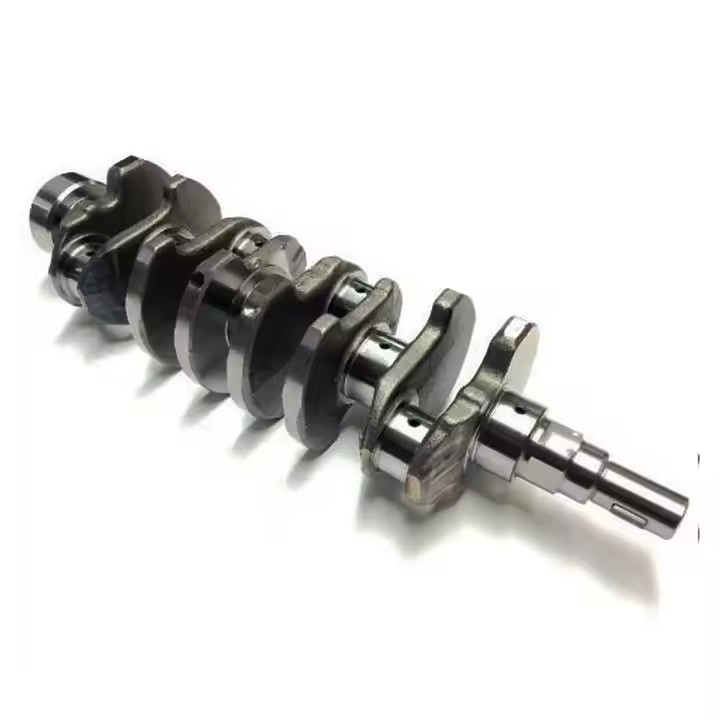1. Insufficient Lubrication
Insufficient lubrication is arguably the leading cause of crankshaft failure. Oil starvation creates metal-on-metal contact, generating excessive heat and friction. This quickly leads to bearing wear, surface damage, and ultimately, crankshaft failure. To be honest, many overlooked maintenance tasks contribute to this problem. Low oil levels, contaminated oil, or a faulty oil pump can all restrict the vital flow of lubricant to the crankshaft bearings. It’s worth noting that even using the wrong viscosity of oil can compromise lubrication effectiveness. A thicker oil might not properly circulate in colder temperatures, while a thinner oil might not provide adequate protection at high temperatures. Regular oil changes, using the manufacturer-recommended oil type, and inspecting the oil pump are critical preventative measures. Furthermore, consider installing an oil pressure gauge to monitor the lubrication system's health and promptly address any drops in pressure.2. Overloading and Detonation
Overloading your engine and operating under conditions that promote detonation can place immense stress on the crankshaft. Detonation, often referred to as "engine knock," is an uncontrolled explosion of the air-fuel mixture in the combustion chamber. This creates shockwaves that can severely damage the pistons, connecting rods, and crankshaft. Frankly speaking, repeatedly exceeding the engine's designed operating limits, such as towing excessive loads or engaging in aggressive driving, can accelerate wear and tear. In my experience, using high-quality fuel with the correct octane rating and avoiding situations that lead to detonation are essential for protecting your crankshaft. Regular engine tuning and diagnostics can also help identify and address potential detonation issues before they cause significant damage.3. Improper Installation and Tightening Torques
Improper installation and incorrect tightening torques during engine assembly or repair can be a major contributor to crankshaft failure. If the main bearings are not properly aligned or the connecting rod bolts are overtightened or undertightened, it can create uneven stress distribution on the crankshaft. This uneven stress can lead to fatigue cracks and eventual failure. Many experts agree that meticulously following the manufacturer's instructions for installation and using a calibrated torque wrench are crucial. It’s also important to ensure that all bearing surfaces are clean and free of debris before assembly. Neglecting these seemingly minor details can have devastating consequences for your engine.4. Material Defects and Manufacturing Flaws
While less common than other causes, material defects and manufacturing flaws can also lead to crankshaft failure. These defects can range from microscopic cracks in the metal to improper heat treating during the manufacturing process. If a crankshaft is made from substandard materials or not properly hardened, it will be more susceptible to fatigue and failure. While you can't always prevent material defects, purchasing crankshafts from reputable manufacturers with rigorous quality control standards can significantly reduce the risk. A thorough visual inspection of the crankshaft before installation can also help identify any obvious defects.5. Torsional Vibration
Torsional vibration, a twisting motion along the crankshaft's length, is a subtle but potentially destructive force. These vibrations are caused by the intermittent firing of the engine's cylinders. If not properly dampened, torsional vibrations can create resonant frequencies that amplify stress on the crankshaft, leading to fatigue cracks and eventual failure. It's worth considering that a properly functioning harmonic balancer is essential for damping these vibrations. Inspecting and replacing the harmonic balancer at regular intervals, as recommended by the manufacturer, is crucial for protecting the crankshaft. Ignoring this crucial component can lead to premature engine failure.6. Misalignment and Balancing Issues
Misalignment of engine components and imbalance in the rotating assembly can induce excessive stress on the crankshaft. Misalignment between the crankshaft and other components, such as the connecting rods or flywheel, can create bending forces that lead to fatigue cracks. Similarly, an unbalanced rotating assembly, including the crankshaft, pistons, and connecting rods, can generate vibrations that accelerate wear and tear. Balancing the rotating assembly during engine rebuilding and ensuring proper alignment of all components during installation are vital preventative measures. Why is this approach so effective? Because it minimizes stress and vibrations, extending the life of the crankshaft.7. Corrosion and Erosion
Corrosion and erosion, while not as prevalent as other causes, can contribute to crankshaft failure, particularly in engines operating in harsh environments. Exposure to corrosive fluids, such as water or coolant, can weaken the crankshaft material and create stress concentration points. Similarly, erosion caused by abrasive particles in the oil can wear away bearing surfaces and compromise lubrication. Regularly inspecting the engine for signs of leaks and using high-quality coolant and oil can help prevent corrosion and erosion. Additionally, ensuring that the air and oil filters are functioning properly can minimize the entry of abrasive particles into the engine. Interestingly enough, even seemingly minor leaks or contamination can have a significant impact on crankshaft longevity over time.Interactive Question:
How often do you inspect your harmonic balancer and oil pressure, and what are some indicators you look for? This is a proactive step in preventing crankshaft issues.Interactive Question:
What type of driving habits do you think contributes the most to crankshaft failures, and what measures can you take to mitigate them? Reflecting on your driving style can make a huge difference.How Our Products/Services Can Help:
Our company specializes in providing high-quality engine components and comprehensive engine diagnostic services. We offer crankshafts manufactured to the highest standards, ensuring exceptional durability and performance. Furthermore, our advanced diagnostic equipment can identify potential issues, such as imbalances or misalignment, before they lead to catastrophic failure. We also provide expert advice and support to help you implement effective preventative maintenance strategies and optimize your engine's performance.Conclusion:
Understanding the common issues that lead to crankshaft failure and implementing preventative strategies is essential for ensuring the longevity and reliability of your engine. From maintaining proper lubrication to addressing torsional vibration and avoiding overloading, taking proactive steps can significantly reduce the risk of costly repairs and downtime. Remember, a healthy crankshaft translates to a healthy engine and years of dependable service.For more detailed information, please visit our official website: https://www.obfe.cn




